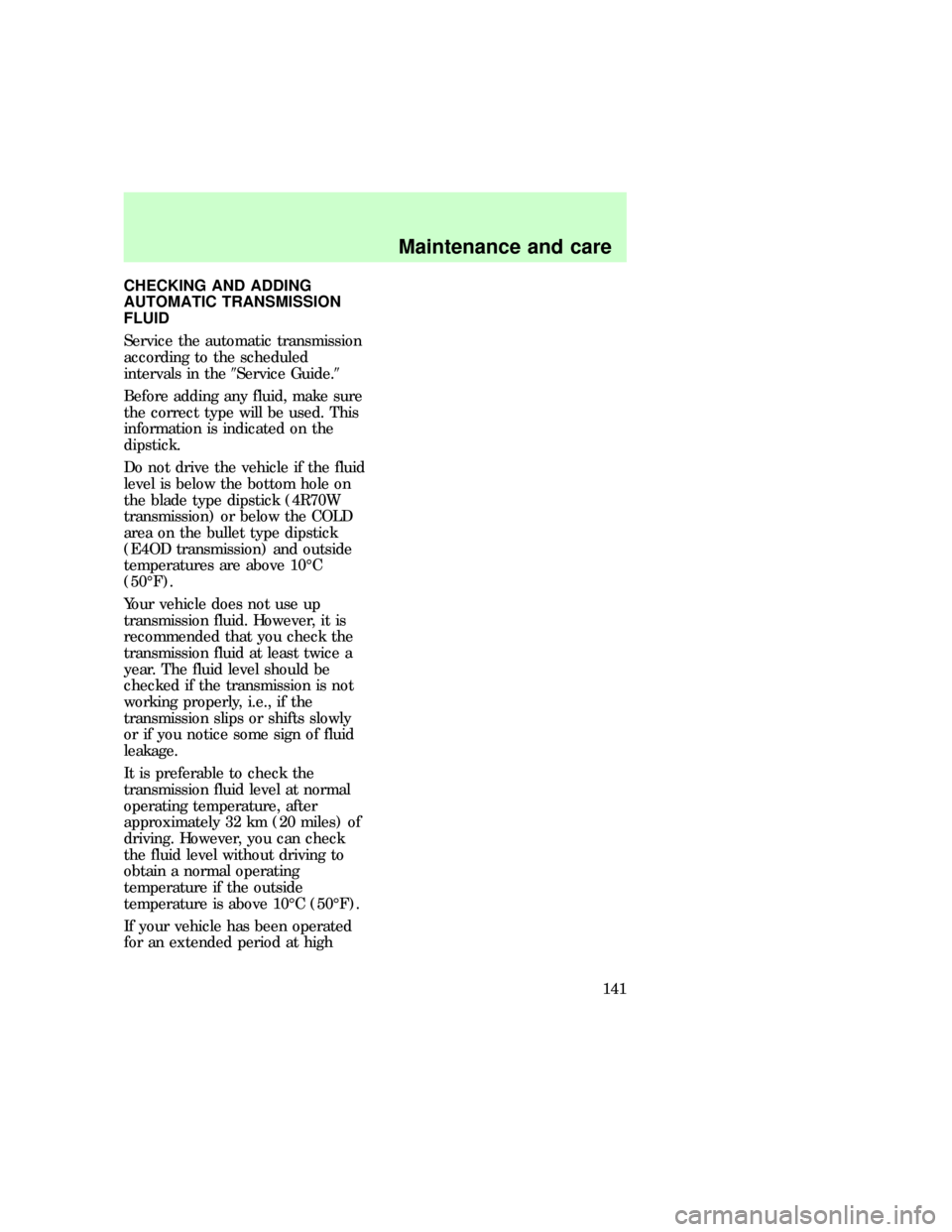Page 98 of 192
must park on a grade, place
wheel chocks under the trailer's
wheels.
²After you have travelled about
80 km (50 miles), thoroughly
check your hitch, electrical
connections and trailer wheel
lug nuts.
Launching or retrieving a boat
When backing down a ramp during
boat launching or retrieval,
²Do not allow the static water
level to rise above the bottom
edge of the rear bumper and
²Do not allow waves to break
higher than 15 cm (six inches)
above the bottom edge of the
rear bumper.
Exceeding these limits may allow
water to enter critical vehicle
components, adversely affecting
driveability, emissions and
reliability.
Servicing when towing
If you tow a trailer for long
distances, your vehicle will require
more frequent service intervals.
Follow the severe duty
maintenance schedule outlined in
the ªService Guide.º
com_launch-retrieving_boat.01
eco_service_when_towing
com_fuel_consumption.01
Driving
98
Page 120 of 192
On vehicles equipped with dual
rear wheels retighten the wheel
lug nuts to the specified torque at
160 km (100 miles), and again at
800 km (500 miles) of new vehicle
operation and at intervals specified
in the ªService Guide.º
On vehicles equipped with single
rear wheels retighten the lug nuts
to the specified torque at 800 km
(500 miles) of operation after any
wheel change or any time the lug
nuts are loosened.
Model Bolt Size Wheel Lug nut Torque*
N²M Ft-Lb
E-150 1/2-20 135 100
E-250, E-350
and E-Super
Duty9/16-18 190 140
* Torque specifications are for nut and bolt threads free of dirt and
rust. Do not use oil or grease on threads. Use only Ford recommened
replacement fasteners.
JUMP STARTING YOUR
VEHICLE
The gases around the
battery can explode if
exposed to flames, sparks, or lit
cigarettes. An explosion could
result in injury or vehicle
damage.
com_jump-starting.01
Roadside emergencies
120
Page 138 of 192
standards for disposing of these
types of fluids. Call your local
recycling center to find out more
about recycling automotive fluids.
Adding engine coolant
Never remove the pressure
cap while the engine is
running or hot.
1. Before you remove the cap, turn
the engine off and let it cool.
2. When the engine is cool, wrap a
thick cloth around the cap and
turn it slowly counterclockwise.
3. Step back while the pressure
releases.
4. When you are sure that all the
pressure has been released, use
the cloth to remove the cap.
5. Add engine coolant until the
level is between the MIN and MAX
lines on the engine coolant
recovery reservoir.
Follow the recommended service
interval for changing engine
coolant as outlined in theService
Guide.
Checking the cooling system
hoses
Inspect all engine and heater
system hoses and hose connections
for:
²deterioration
²leaks
MAX FILL
MIN FILL
eco_adding_coolant
eco_checking_hoses
Maintenance and care
138
Page 141 of 192

CHECKING AND ADDING
AUTOMATIC TRANSMISSION
FLUID
Service the automatic transmission
according to the scheduled
intervals in the9Service Guide.9
Before adding any fluid, make sure
the correct type will be used. This
information is indicated on the
dipstick.
Do not drive the vehicle if the fluid
level is below the bottom hole on
the blade type dipstick (4R70W
transmission) or below the COLD
area on the bullet type dipstick
(E4OD transmission) and outside
temperatures are above 10ÉC
(50ÉF).
Your vehicle does not use up
transmission fluid. However, it is
recommended that you check the
transmission fluid at least twice a
year. The fluid level should be
checked if the transmission is not
working properly, i.e., if the
transmission slips or shifts slowly
or if you notice some sign of fluid
leakage.
It is preferable to check the
transmission fluid level at normal
operating temperature, after
approximately 32 km (20 miles) of
driving. However, you can check
the fluid level without driving to
obtain a normal operating
temperature if the outside
temperature is above 10ÉC (50ÉF).
If your vehicle has been operated
for an extended period at high
Maintenance and care
141
Page 144 of 192
DRIVELINE UNIVERSAL JOINT
AND SLIP YOKE
The universal joints standard with
your vehicle do not require
lubrication. If the original
equipment universal joints are
replaced with universal joints
equipped with grease fittings,
lubrication will be necessary at the
intervals shown in the ªService
Guideº supplement.
BATTERY
If the original equipment
maintenance-free battery needs
replacing, it may be replaced with
a low-maintenance battery. For
information on replacement
batteries, refer toMotorcraft part
numbersin theCapacities and
specificationschapter.
The gases around the
battery can explode if
exposed to flames, sparks, or lit
cigarettes. An explosion could
result in injury or vehicle
damage.
Batteries contain sulfuric
acid which burns skin,
eyes, and clothing.
eco_battery1
eco_servicing_battery1
Maintenance and care
144
Page 154 of 192
The cold pressure amount is listed
on the Safety Compliance
Certification label.
Improperly inflated tires
can affect vehicle handling
and can fail suddenly, possibly
resulting in loss of vehicle
control.
Rotating the tires
Rotate your tires at regular
intervals for even wear. Rotation
intervals are listed in theService
Guide.
²Four tire rotation
eco_rotating_tiresMaintenance and care
154
Page 162 of 192
²Use only unleaded fuel.
²Avoid running out of fuel.
²Do not turn off the ignition
while the vehicle is in motion.
²Have regular maintenance
checks performed according to
the intervals in theService
Guide.
When servicing your vehicle, never
use a metal exhaust collector. A
metal collector may melt or deform
plastic parts.
Do not park, idle, or drive
your vehicle in dry grass
or other dry ground cover. The
emission system heats up the
engine compartment and exhaust
system, which can start a fire.
If you smell exhaust fumes
inside your vehicle, have
your dealer inspect your vehicle
immediately. Do not drive if you
smell exhaust fumes.
On vehicles without
original equipment floor
covering or insulation, do not let
passengers ride in your truck in
a manner that allows contact
between skin and the metal floor.
If you notice one or more of the
following, the emissions system
may not be working properly. Have
your vehicle serviced as soon as
possible.
Maintenance and care
162